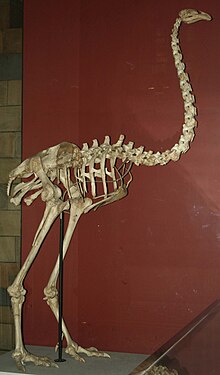
Back Moa meur an norzh Breton Dinornis novaezealandiae Esperanto Dinornis novaezealandiae Spanish غولشترمرغ جزیره شمالی Persian Moa géant de l'île du Nord French Novozelandska moa Croatian Északi óriásmoa Hungarian ジャイアントモア Japanese მოა Georgian Nordøykjempemoa NB
| North Island giant moa Temporal range: Late Pleistocene- Holocene
| |
|---|---|

| |
| Skeleton, Natural History Museum of London | |
| Scientific classification | |
| Domain: | Eukaryota |
| Kingdom: | Animalia |
| Phylum: | Chordata |
| Class: | Aves |
| Infraclass: | Palaeognathae |
| Order: | †Dinornithiformes |
| Family: | †Dinornithidae |
| Genus: | †Dinornis |
| Species: | †D. novaezealandiae
|
| Binomial name | |
| †Dinornis novaezealandiae | |
| Synonyms | |
|
List
| |
| Measurements | |||
|---|---|---|---|
| North Island [3] | |||
| Length | 240 cm (94 in) | ||
| 300 cm (120 in) | |||
| Weight | 55–88 kg (120–190 lb) | ||
| 78–249 kg (170–550 lb) | |||
The North Island giant moa (Dinornis novaezealandiae) is an extinct moa in the genus Dinornis, known in Māori as kuranui.[4] Even though it might have walked with a lowered posture, standing upright, it would have been the tallest bird ever to exist, with a height estimated up to 3.6 metres (12 ft).[citation needed]
- ^ Brands, S. (2008)
- ^ Checklist Committee Ornithological Society of New Zealand (2010). "Checklist-of-Birds of New Zealand, Norfolk and Macquarie Islands and the Ross Dependency Antarctica" (PDF). Te Papa Press. Retrieved 4 January 2016.
- ^ Birds of New Zealand[not specific enough to verify]
- ^ Doyle, Trent (15 November 2023). "Scientists reveal fossilised moa footprints in Otago are at least 3.6 million years old". Newshub. Retrieved 23 February 2024.